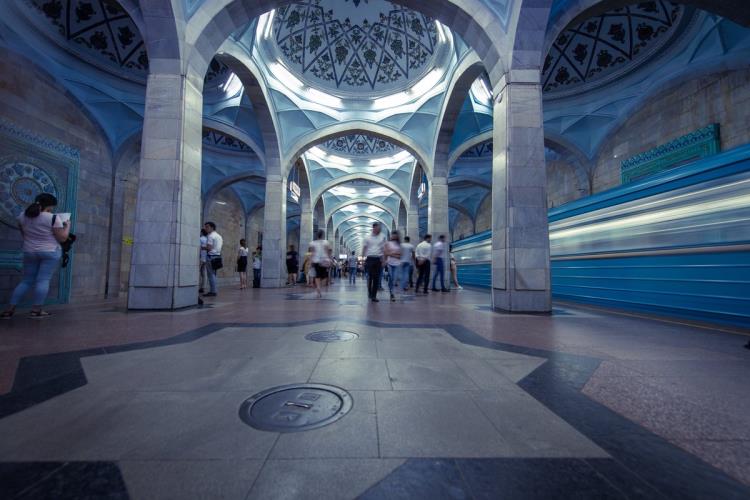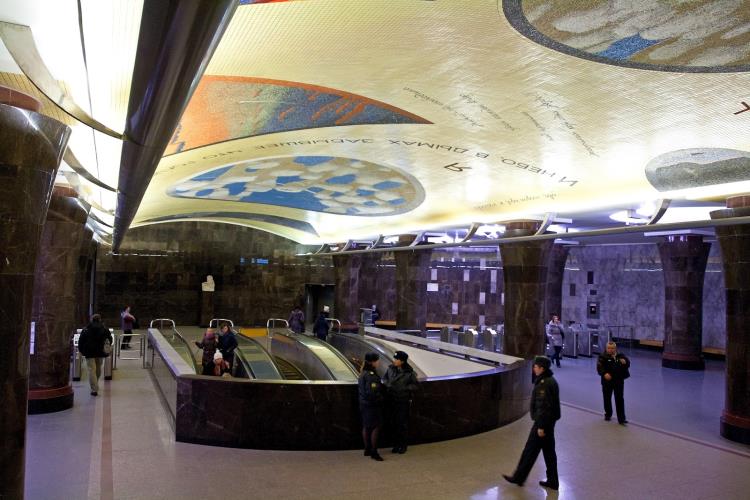Yap loves design, travel and everything beautiful in life. He writes for various media about travel and design and has published works, including Wander Bhutan and Myanmar Odyssey. Formerly publisher of Lonely Planet (China Office), Yap is now Chief Content Officer of Youpu Apps, a Beijing based travel app company.
I have recently travelled to central Asia and Russia. When I was in The Republic of Uzbekistan’s capital, Toshkent, I was surprised by the city’s clean environment and that the city actually has a metro system. In the 60s, a massive earthquake struck Toshkent, turning the entire city into ruins and debris. The infrastructures you now see in the city were all built after that devastating earthquake, including the metro system. Built in the 70s, taking photos in the metro was strictly forbidden for safety concerns. It wasn’t until June this year that the restriction was lifted. That was when the world finally started to see the magnificent metro system under Toshkent.

Metro station with rich cultural elements in Uzbekistan
Toshkent’s metro system has three lines, with a total length of less than 40 km. Despite the relatively small scale, Toshkent’s metro system has 29 stations with distinct designs. It is also the first metro system in central Asia. If you are interested in Soviet Union designs, the metro system there will be a paradise for you. Toshkent’s metro system was designed based on the blueprint of Moscow’s metro system. Although the metro system is not as grand and luxurious as the one in Moscow, its unique metro stations are still stunning with interesting local cultural elements. Travelling between different metro stations in Toshkent can help us understand the local culture.
The Ming O’rik staion was designed with apricot elements. In O’zbek tili, Ming O’rik means a thousand apricots. Apricot happens to be a local special produce in Uzbekistan. At the Bodomzor station, there are elements of pepper and bread, which are two of local people’s favourite food. At Pakhtakor station, on the other hand, you can find a mosaic mural of cotton. Cotton is an important agricultural product of the country. October is the month for the harvest. In every corner of Uzbekistan, you can bump into cotton fields. In fact, Uzbekistan is the sixth largest cotton exporter in the world. The clothes we are wearing right now are probably made of the cottons from Uzbekistan.

Metro station with rich cultural elements in Moscow
From Toshkent I reached Moscow and paid a visit to the city’s metro system. Moscow’s metro system is like a fancy museum. Komsomolskaya station is one of the most beautiful metro stations in Moscow. The station’s platform is as delicate as a royal palace. The station decorated with incredible stone carvings and shining chandeliers, making each departure and arrival sacred. Commuters pass by beautiful stations like this every day. They must be more or less influenced by the elegant design. Mayakovskaya station is my personal favourite. Each time I passed by the Mayakovskaya station, I had the urge to get off the train and explore the station. The station was awarded at the 1938 New York World’s Fair. The platform features a simplistic design with classic elements of Art Deco. The station has streamlined columns faced with stainless steel and pink rhodonite. The interior decoration of the station is also stunning. One station is decorated with light fixtures that make up a molecular structure diagram in memory of Dmitri Ivanovich Mendeleev, the discoverer of the periodic table of chemical elements. Locals in Moscow are very proud of their metro stations. Some tour service providers in Moscow even offer metro tours to tourists. The metro trains are clean. You can’t really find graffiti on the trains. There is no doubt that people here value their metro trains a lot as the trains are so well maintained despite a large number of commuters.
The train carriages are quite old but are equipped with modern conveniences such as Wi-Fi. For me, the trains are very elegant because they are the representation of the aesthetics from the Soviet Union. The metro system in Moscow is deep underground because it was intended to serve as a bomb shelter during wartime. The Wi-Fi infrastructure was installed to allow commuters to stay connected to the Internet since the cell phone signal is not stable in deep underground. Moscow’s metro system also has a high frequency of metro trains. I had used the metro during the rush hours several times and it wasn’t really crowded. The 80-year-old metro system in Moscow transports nine million commuters to their destination every day. Living in Moscow is not cheap. The daily expense here could be as expensive as cities in West Europe. However, the metro ticket in Moscow costs around HKD5. Despite the low price, Moscow’s metro is serving people with world-class quality. Only when we are travelling can we see the world clearly and have a deeper reflection on our own city.